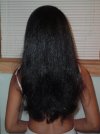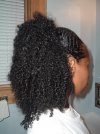MzSwift
Well-Known Member
The bolded you stated is ABSOLUTELY FASCINATING, Wow! Thank you @MzSwift! Thank you @Napp for mentioning this initially!
I have not looked through the posted above hair threads, yet. Here is my take on this right now:
I'm a Kitchen Technician and a Kitchen Beautician so let me see hmmm....
Salt has a pH of around 8. It is a base. It is basic and raises the pH of water. What a base does is swell the hair. The hair expands and becomes pliable also called softer, or a fancier word is plasticized>
If the hair is relaxed, it is pretty much a guarantee that the hair is porous and damaged. In my world hair is either porous or not. High porosity is damaged hair, based upon my understanding of hair. I a open to be enlightened, though!
Even beautiful relaxed hair is damaged due to the change of the lye/or no lye process. Not only is the hair strand expanded, and swollen, it is swollen with water. Water is a Master Conductor or Mistress Conductrice. Sorry, I'm too old to pretend to be versed on 'binary terms'. But, I've mentioned it. I digress. Back on topic:
Now, add in amino acids, those tiny molecules can then enter into the hair shaft, especially the sulphur molecules. Those aminos can fortify the hair strand, at least temporarily. With a hair strand swollen, cuticles raised and wet, that is an ideal situation or environment for amino acids to go into the hair or that is an ideal way to facilitate the entry of amino acids into the hair strand.
The heat softens the hair and makes it even more pliable. I know that we have salt bonds in our hair. The salt bonds impact the elasticity and strength of hair. But, my gut tells me that the added iodized salt is probably not participating in any hair bond formation. I think the iodized salt is changing the pH of the hair strand environment, the water, which causes those salt bonds in the hair to be impacted. Now add in the heat which also impacts the salt and hydrogen bonds of the hair and boom: a change in texture and feel of the hair, ie - BUTTER HAIR!
I'm going to try this!!!!!
@GGsKin
@snoop
@caribeandiva
@sunnieb
ONE CAUTION! Baking soda usage:
I personally would not add baking soda to the mix. Why? Baking soda is abrasive. It can literally tear off the the precious cuticles on the hair strand. Baking soda is basic too, in terms of its pH. But the issue is not the impact of the pH, a chemical change. The potential or theoretical issue with baking soda is the physical and mechanical changes or damages it can do to a hair strand. Hair that has been stripped of its cuticles can appear and feel softer and straighter. BUT, what is happening is the hair has had a critical part of its physical structure removed and it becomes limp and unprotected. Breakage will likely follow.
LOL at Kitchen Technician!
OMG, I LOVE this!!!
Thank you, sis!
It makes sense to me!
I don't think I've really noticed a difference using the salt as a natural and then relaxed/texlaxed. It just became my holy grail. I wish I were paying closer attention to see how different my relaxed and natural hair responded.
Oops, I didn't mean to confuse anyone reading, I don't use salt and baking soda together!! Again, I'm a chicken. lol
I use the salt+hibiscus DC as a moisturizing DC following a protein tx (not the amino acid one).
I use the Amino Acid tx (with baking soda + amino acids) as a DC before I straighten my hair when I'm stretching my relaxer because it makes my new growth easier to manipulate and I get straighter results when I flat iron or blowout.




